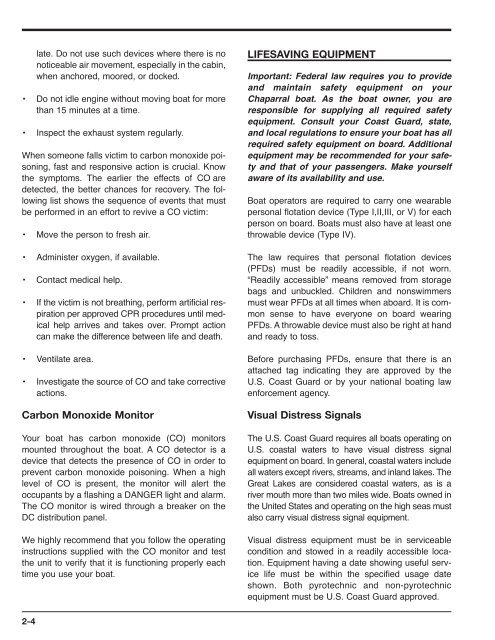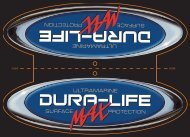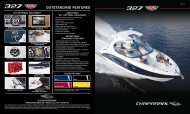OWNER'S/OPERATOR'S MANUAL - Chaparral Boats Owners Club
OWNER'S/OPERATOR'S MANUAL - Chaparral Boats Owners Club
OWNER'S/OPERATOR'S MANUAL - Chaparral Boats Owners Club
Create successful ePaper yourself
Turn your PDF publications into a flip-book with our unique Google optimized e-Paper software.
late. Do not use such devices where there is nonoticeable air movement, especially in the cabin,when anchored, moored, or docked.• Do not idle engine without moving boat for morethan 15 minutes at a time.• Inspect the exhaust system regularly.When someone falls victim to carbon monoxide poisoning,fast and responsive action is crucial. Knowthe symptoms. The earlier the effects of CO aredetected, the better chances for recovery. The followinglist shows the sequence of events that mustbe performed in an effort to revive a CO victim:• Move the person to fresh air.• Administer oxygen, if available.• Contact medical help.• If the victim is not breathing, perform artificial respirationper approved CPR procedures until medicalhelp arrives and takes over. Prompt actioncan make the difference between life and death.• Ventilate area.• Investigate the source of CO and take correctiveactions.Carbon Monoxide MonitorYour boat has carbon monoxide (CO) monitorsmounted throughout the boat. A CO detector is adevice that detects the presence of CO in order toprevent carbon monoxide poisoning. When a highlevel of CO is present, the monitor will alert theoccupants by a flashing a DANGER light and alarm.The CO monitor is wired through a breaker on theDC distribution panel.We highly recommend that you follow the operatinginstructions supplied with the CO monitor and testthe unit to verify that it is functioning properly eachtime you use your boat.liFesavinG equiPMenTImportant: Federal law requires you to provideand maintain safety equipment on your<strong>Chaparral</strong> boat. As the boat owner, you areresponsible for supplying all required safetyequipment. Consult your Coast Guard, state,and local regulations to ensure your boat has allrequired safety equipment on board. Additionalequipment may be recommended for your safetyand that of your passengers. Make yourselfaware of its availability and use.Boat operators are required to carry one wearablepersonal flotation device (Type I,II,III, or V) for eachperson on board. <strong>Boats</strong> must also have at least onethrowable device (Type IV).The law requires that personal flotation devices(PFDs) must be readily accessible, if not worn.“Readily accessible” means removed from storagebags and unbuckled. Children and nonswimmersmust wear PFDs at all times when aboard. It is commonsense to have everyone on board wearingPFDs. A throwable device must also be right at handand ready to toss.Before purchasing PFDs, ensure that there is anattached tag indicating they are approved by theU.S. Coast Guard or by your national boating lawenforcement agency.visual distress signalsThe U.S. Coast Guard requires all boats operating onU.S. coastal waters to have visual distress signalequipment on board. In general, coastal waters includeall waters except rivers, streams, and inland lakes. TheGreat Lakes are considered coastal waters, as is ariver mouth more than two miles wide. <strong>Boats</strong> owned inthe United States and operating on the high seas mustalso carry visual distress signal equipment.Visual distress equipment must be in serviceablecondition and stowed in a readily accessible location.Equipment having a date showing useful servicelife must be within the specified usage dateshown. Both pyrotechnic and non-pyrotechnicequipment must be U.S. Coast Guard approved.2-4

















